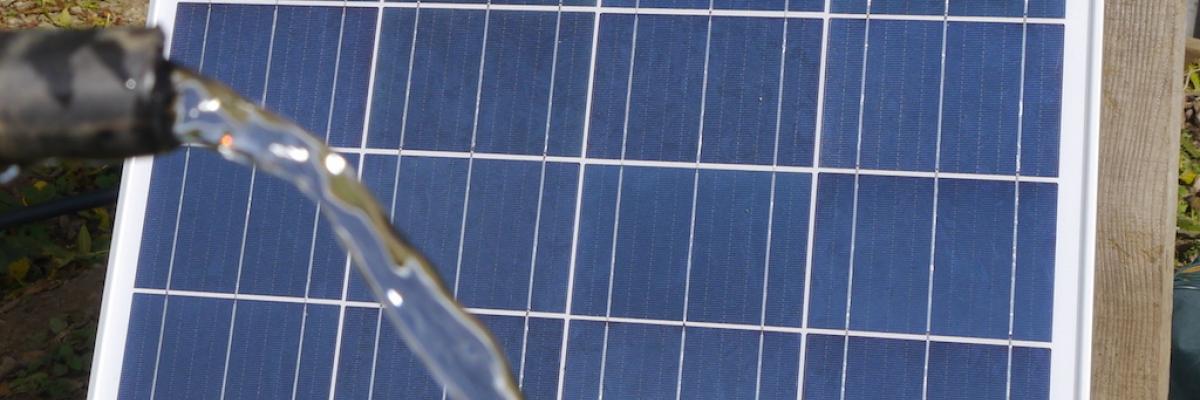Submitted by mike on

A couple of days ago, Phillip, who's been involved with Carraig Dulra since the beginning and who recently was the Solar Energy tutor at the Tiny House workshops, kindly agreed to bring over some of his solar equipment to the old cottage that Suzie and I are restoring. The cottage hasn't been lived in for 5-10 years, and has no ESB hookup. There's no water mains, but there is a well; the pump originally ran on mains electricity but I had the pump tested, and even if we had electricity, we'd still need a new pump.
Mains Electric
So the conventional solution would be to get ESB hooked in (which also means getting the house rewired) and a replacement water pump. Costs for an ESB connection are about €1,800, and the rewiring would be anywhere up to €3,500, although I would do a lot of the running of wires myself and just get in a sparks to do the connections, but even so there is some cost there.
There was good news regarding the pump, however, as Wicklow County Council's environment section were very helpful, and approved us for a grant that covers 75% of the cost of a replacement pump & associated works and some funds towards a new well if one needed to be drilled. Cost for getting the new pump + installation etc would be roughly €1,300, so for that part of the project the cost to us would be a bit more than €300.
Off grid
Before we went down that road, however, we wanted to explore off-grid. I spoke with Phillip about running the water pump off grid. First we considered powering the proposed replacement pump (0.75 hp). The power required would be pretty hefty, so an off grid system would have to be bigger because of this. As an alternative, he suggested we try a lower-powered pump, running directly on DC.
Water storage
The considerations here are that a lower powered pump would be slower, but my experience with Carraig Dulra's ram pump was that a slow pump is fine as long as you have have a big reservoir of water. At the farm, we have 3000+ litres of water tanks that are constantly filling from the (non-electrical) Ram pump, and we rarely run out of water. So at the cottage, we could do something similar, and then the cottage water would come not directly from the pump, but from the storage tank, which would be uphill from the cottage.
To power the pump a solar panel's electricity could be fed directly into the pump. That is, no "battery", since effectively the water storage tank is like a battery, storing the water that will be pumped during sunny days, for use on overcast days and at night.
Trying it out
That's all good theory, so Phillip called in with his bag of tricks on what the forecast said would be the clearest day of the week. We got everything hooked up but the weather didn't clear, so we tried the pump from a car battery. This made the pump run but wasn't enough power to get any water up. So we left in the hopes that a sunnier day would let us try the panel.
The following day was also overcast, but there were a few sunny patches, so I went back in the hopes that I would be there when the clouds parted. The 12v battery hadn't been enough, so I knew we needed more than 12v. After hooking the solar panel and pump together and waiting a while, eventually I got a slightly brighter patch which gave about 15 volts, and a dribble of water started coming out! After ringing Philip to celebrate, we discussed the possibility that a second panel might be required. However after I hung up, we got a brighter spell for 10-15 minutes which gave more power and the pump was pushing out about 5 litres of water per minute! And this was only partial sun on an October's day.
Is that good enough?
To know if this could actually be a viable solution, I need to estimate how much water we use each day, and how many sunny hours we'd likely get during the darkest parts of the year.
The UK's consumer council for water gives an estimate of 450 litres/day for a family of 4. I think this is far more than we'd use, but in fairness to them, they do say "Because water usage varies enormously, it is difficult to give a precise answer on average water use." However, let's use that figure for now.
Met Eireamm estimate that December, the dullest month of the year, gives us on average 1-2 hours of sun per day (depending on where you are in Ireland). I'll use 1.5 hours.
So based on these figures, the 1.5 hours/day of sun we'd get in December would be just enough to give us 450 litres of water/day. So in theory we would have enough water.
In fact, even assuming all those figures are right, of course you don't actually get 1.5 hours evenly distributed one day per week. Typically you get a beautiful day, and then pay for it with a run of dirty weather. So the size of the storage tank required would depend on how many days water storage we'd want to keep in reserve for the darkest part of the year. Easy enough using the same figures, that's 450 litres for each day. If we go with 5 days, that's 2250 litres. Of course no matter how big or small the storage tanks, we could always top up the water storage as needed with a generator to drive the pump if we were unlucky and had a long run of dark days. Less ecologically friendly but it would probably not be needed too often.
The storage tanks themselves are a cost unless you have access to them. Looking at what you use water for, only a tiny amount of it is for drinking. Drinking water needs to be in a black closed drinking water tank; these are expensive. Water for washing and flushing a loo (assuming you aren't using a compost toilet) takes up most of the consumption, and the requirements for how you store non-potable water are less onerous, I'm thinking a IBC painted black; I know you can get IBC's, which hold 1000 litres, for €50-€70 each. One consideration with IBC's is, what was stored it in before you bought it, and would there be any residue of a potentially dangerous chemical left inside? We were lucky enough to source IBCs for the farm that came from food processing factories, so we knew they were safe. I'll try and do the same again.
Costs
The pump we used and the solar panel cost about €120 each; there were a few other connectors and a length of electrical wire and pipe that went down the pump, some silicon and optional volt meter and amp meter (about €10) . Watching the meters and the sky was very interesting, how slight variations in brightness really made a big difference in solar panel output, so I'd recommend including meters in any installation.
Tanks and Compost Shower!
So next steps are to set up tanks and then draw the water from them into the house to see how the pressure is. Once we have our water supply sorted, we're looking into building a compost-heated shower (as was used at the recent Permaculture Gathering). This basically uses the heat from a compost heap to warm the water in pipes, which are inside the heap. Suzie tells me the showers at the Gathering were very warm, so looking forward to further experimentation!

